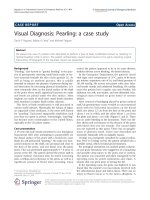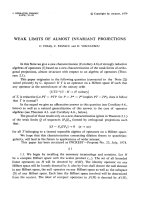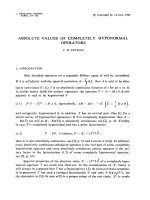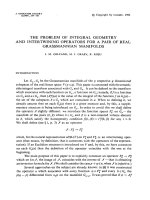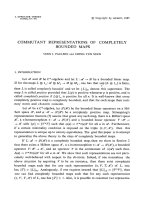Báo cáo toán học: "Matrix-free proof of a regularity characterization" doc
Bạn đang xem bản rút gọn của tài liệu. Xem và tải ngay bản đầy đủ của tài liệu tại đây (124.54 KB, 11 trang )
Matrix-free proof of a regularity characterization
A. Czygrinow
Department of Mathematics and Statistics
Arizona State University, Tempe, Arizona 85287, USA
B. Nagle
Department of Mathematics and Statistics
University of Nevada, Reno, Nevada 89557, USA
Submitted: May 28, 2003; Accepted: Oct 7, 2003; Published: Oct 13, 2003
MR Subject Classifications: 05C35, 05C80
Abstract
The central concept in Szemer´edi’s powerful regularity lemma is the so-called
ε-regular pair. A useful statement of Alon et al. essentially equates the notion of an
ε-regular pair with degree uniformity of vertices and pairs of vertices. The known
proof of this characterization uses a clever matrix argument.
This paper gives a simple proof of the characterization without appealing to the
matrix argument of Alon et al. We show the ε-regular characterization follows from
an application of Szemer´edi’s regularity lemma itself.
1 Introduction
The well-known Szemer´edi Regularity Lemma [7] (cf. [4] or [5]) may be the single most
powerful tool in extremal graph theory. Roughly speaking, this lemma asserts that every
large enough graph may be decomposed into constantly many “random-like” induced
bipartite subgraphs (i.e. “ ε-regular pairs”). A property of the ε-regular pairs obtained
from Szemer´edi’s lemma is studied in this note.
Suppose G =(U ∪ V,E) is a bipartite graph. For nonempty subsets U
⊆ U and
V
⊆ V ,letG[U
,V
]={{u, v}∈E : u ∈ U
,v ∈ V
} be the subgraph of G induced on U
and V
.Setd(U
,V
)=|G[U
,V
]||U
|
−1
|V
|
−1
to be the density of U
and V
.Forε>0,
we say G =(U ∪V,E)isε-regular if for all U
⊆ U, |U
| >ε|U|,andV
⊆ V , |V
| >ε|V |,
we have
1
d(U
,V
)=d(U, V ) ± ε.
1
For simplicity of calculations in this paper, s =(a ± b)t is short for (a − b)t ≤ s ≤ (a + b)t.
the electronic journal of combinatorics 10 (2003), #R39 1
1.1 Equivalent conditions for ε-regularity
We consider the following two conditions for a bipartite graph G =(U ∪ V, E)with
fixed density d (where, whenever needed, we assume |U| and | V | are sufficiently large).
For 0 <ε,δ≤ 1, consider
G
1
= G
1
(ε) G is ε-regular.
G
2
= G
2
(δ)(i)deg
G
(u)=(d ±δ)|V | for all but δ|U| vertices u ∈ U,
(ii)deg
G
(u, u
)=(d ±δ)
2
|V | for all but δ|U|
2
distinct pairs u, u
∈ U.
1.1.1 G
1
⇐⇒ G
2
The following fact, called the intersection property, is part of the folklore and is easily
proved from the definition of ε-regularity (cf. [5]).
Fact 1.1 (Intersection Property, G
1
=⇒ G
2
) For all 0 <ε<d/2, G
1
(ε)=⇒ G
2
(4ε).
In this sense, G
1
=⇒ G
2
.
The following non-trivial theorem was proved by Alon, Duke, Lefmann, R¨odl and
Yuster in [1] and by Duke, Lefmann and R¨odl in [2].
Theorem 1.2 (G
2
=⇒ G
1
) For al l δ>0, G
2
(δ)=⇒ G
1
(16δ
1/5
). In this sense, G
2
=⇒
G
1
.
We mention that the proof of Theorem 1.2 in [1] (cf. [2]) is elegant and far from obvious.
We return to this point momentarily.
Fact 1.1 and Theorem 1.2 give an equivalence between the conditions G
1
and G
2
.
Corollary 1.3 (G
1
⇐⇒ G
2
) For every δ>0 there exists ε>0 (viz. ε = δ/4)so
that G
1
(ε)=⇒ G
2
(δ) and for every ε>0 there exists δ>0 (viz. δ = ε
5
/16)sothat
G
2
(δ)=⇒ G
1
(ε). In this sense, G
1
⇐⇒ G
2
.
We make the following remark.
Remark 1.4 (Corollary 1.3 =⇒ Algorithmic SRL) The original proof of Szemer´edi’s
Regularity Lemma was non-constructive. Alon, Duke, Lefmann, R¨odl and Yuster [1] (cf.
[2]) subsequently established an algorithmic version of the regularity lemma which effi-
ciently constructs the “regular environment” Szemer´edi’s lemma provides. The central
tool in the proof of the algorithmic version of Szemer´edi’s lemma is Corollary 1.3.
the electronic journal of combinatorics 10 (2003), #R39 2
1.1.2 The matrix proof of Theorem 1.2
We briefly describe the matrix construction which verifies Theorem 1.2. Let G =
(U ∪ V,E) satisfy G
2
= G
2
(δ)wherewesetε =16δ
1/5
.ToshowG is ε-regular, set
ρ = d
−1
(1 −d) and construct {−1,ρ}-matrix M =(m
uv
)
u∈U,v∈V
by setting m
uv
= ρ ⇐⇒
{u, v}∈G. Let r
u
denote the row vector associated with u ∈ U.
Now, let U
⊆ U, |U
| >ε|U|, V
⊆ V , |V
| >ε|V |, be given. One may establish (cf.
[2])
d(U
,V
)
d
− 1
2
≤|U
|
−2
|V
|
−1
u∈U
r
u
· r
u
+2
{u,u
}∈[U
]
2
r
u
· r
u
.
where “ · ” denotes scalar product for vectors. The inequality |d(U
,V
) − d| <εthen
follows from manipulating the expression above using the hypothesis G
2
(δ).
1.2 Content of this Note
We work with the following simplified condition
2
G
2
= G
2
(δ)deg(u, u
)=(d ±δ)
2
|V | for all but δ|U|
2
pairs u, u
∈ U.
Our goal is to prove the following theorem.
Theorem 1.5 (G
2
=⇒ G
1
) For al l ε>0, there exists δ so that G
2
(δ)=⇒ G
1
(ε).
We note that our result, Theorem 1.5, is a bit weaker than Theorem 1.2 in the sense that
our constant δ = δ(ε) is considerably smaller than ε
5
/16.
In our proof of Theorem 1.5, we do not appeal to the matrix argument of Section 1.1.2.
We show G
2
=⇒ G
1
follows directly from an application of the Szemer´edi Regularity
Lemma itself.
2 Proof of Theorem 1.5
In this section, we prove Theorem 1.5. In our proof, G =(U ∪ V,E)alwaysrepresentsa
bipartite graph of density d with m = |U|≤|V | = n. We state, up front, that we always
assume m is a sufficiently large integer.
Our proof of Theorem 1.5 uses a well-known invariant formulation of Szemer´edi’s
Regularity Lemma. We now present that formulation.
2
As noted by Kohayakawa, R¨odl and Skokan [3], statement (i) of condition G
2
is not actually needed.
Indeed, as shown in Claim 5.3 of [3], statement (i) of condition G
2
(δ
) follows from statement (ii)of
condition G
2
(δ), for a suitable δ, using a Cauchy-Schwarz argument.
the electronic journal of combinatorics 10 (2003), #R39 3
2.1 An Invariant of Szemer´edi’s Regularity Lemma
Let G =(U ∪ V, E) be a bipartite graph. For an integer t, we define a t-equitable
partition V (G) as a pair of partitions U = U
1
∪ ∪U
t
, V = V
1
∪ ∪ V
t
,where
m
t
=
|U|
t
≤|U
1
|≤ ≤|U
t
|≤
|U|
t
=
m
t
and
n
t
=
|V |
t
≤|V
1
|≤ ≤|V
t
|≤
|V |
t
=
n
t
.
In all that follows, o(1) → 0asm →∞. Thus, in the remainder of this paper, we
may say that for each 1 ≤ i ≤ t,
|U
i
| =
m
t
(1 ± o(1)), |V
i
| =
n
t
(1 ± o(1)). (1)
For convience of notation, we write G
ij
= G[U
i
,V
j
]andd
ij
= d
G
(U
i
,V
j
), 1 ≤ i, j ≤ t.
For ε
0
> 0, we say a t-equitable partition U = U
1
∪ ∪ U
t
, V = V
1
∪ ∪ V
t
,is
ε
0
-regular if all but ε
0
t
2
biparite graphs G
ij
,1≤ i, j ≤ t,areε
0
-regular.
Theorem 2.1 (Regularity Lemma) For every ε
0
> 0 and positive integer t
0
, there
exists N
0
and T
0
so that every bipartite graph G =(U∪V, E) with n = |V |≥m = |U|≥N
0
admits a t-equitable, ε
0
-regular partition U = U
1
∪ ∪U
t
, V = V
1
∪ ∪V
t
,fort
0
≤ t ≤ T
0
.
Note that the proof of Theorem 2.1 takes an existing parition and refines it. As a result,
clusters U
i
are subsets of U and clusters V
j
are subsets of V .
2.2 ε
0
-regular partitions and G
2
(δ)
The following statement, expressed in Proposition 2.2, will imply Theorem 1.5 almost
immediately.
Proposition 2.2 Let d, ε
0
> 0 be given along with an integer t.Let0 <δ<ε
0
/t
2
be
given. Let G =(U ∪ V,E) be a bipartite graph of density d satisfying G
2
(δ) and let
U = U
1
∪ ∪ U
t
, V = V
1
∪ ∪ V
t
,beanε
0
-regular, t-equitable partition of V (G).
Then, at most 5ε
1/3
0
t
2
pairs U
i
, V
j
, 1 ≤ i, j ≤ t, fail to both be ε
0
-regular and satisfy
d
ij
= d ± 5ε
1/3
0
.
Note that Proposition 2.2 essentially says that with appropriate constants
3
, property
G
2
(δ) forces the density d to be preserved throughout almost all bipartite graphs G
ij
,
1 ≤ i, j ≤ t, of the partition. As almost all bipartite graphs G
ij
,1≤ i, j ≤ t,arealso
ε
0
-regular, ε
0
ε, the preserved densities quickly imply the ε-regularity of G.
3
Here, one may think of the hierarchy “ d ε
0
1/t δ”.
the electronic journal of combinatorics 10 (2003), #R39 4
2.3 Proof of Theorem 1.5
Before proceeding to the proof of Theorem 1.5, we begin by describing the constants
involved, the setup we use and a few preparations we make. We begin with the constants.
2.3.1 The Constants
Let d, ε > 0begiven.Todefinethepromisedconstantδ>0, set auxiliary constants
ε
0
=(d
3
ε
15
)/20
3
(2)
and t
0
=1. LetT
0
= T
0
(ε
0
, 1) be the constant guaranteed by Theorem 2.1. Define
δ = ε
0
/2T
2
0
.
2.3.2 The Setup
Let G =(U ∪ V,E) be a bipartite graph of density d satisfying G
2
(δ) where the
integers |V | = n ≥ m = |U| are sufficiently large.
We show G is ε-regular. To that end, let U
⊆ U, V
⊆ V , |U
| >εm, |V
| >εn,be
given. We show d
G
(U
,V
)=d ±ε.
2.3.3 Preparations
We begin by applying Theorem 2.1 to G. With auxiliary constants ε
0
=(d
3
ε
15
/20
3
)
and t
0
= 1, Theorem 2.1 guarantees constants T
0
= T
0
(ε
0
, 1) and N
0
= N
0
(ε
0
, 1). With
n = |V |≥|U| = m ≥ N
0
, we may apply Theorem 2.1 to G to obtain an ε
0
-regular,
t-equitable partition U = U
1
∪ ∪ U
t
, V = V
1
∪ ∪ V
t
,where1=t
0
≤ t ≤ T
0
.Note,
importantly, that T
0
= T
0
(ε
0
, 1) is precisely the same constant we saw above when we set
δ = ε
0
/(2T
2
0
). In this way, we are ensured δ<ε
0
/t
2
.
We now wish to apply Proposition 2.2 to G and its ε
0
-regular, t-equitable partition
U = U
1
∪ ∪U
t
, V = V
1
∪ ∪V
t
, obtained above. Note that we may apply Proposition
2.2 (since δ<ε
0
/t
2
). Applying Proposition 2.2, we are guaranteed that all but 5ε
1/3
0
t
2
pairs U
i
, V
j
,1≤ i, j ≤ t,areε
0
-regular and satisfy d
ij
= d ±5ε
1/3
0
.
Now, define graph G
0
to have vertex set [t] × [t]where
G
0
=
(i, j) ∈ [t] ×[t]: G
ij
is ε
0
-regular with density d
ij
= d ± 5ε
1/3
0
.
Set G
C
0
=([t] ×[t]) \G
0
.
In the notation G
C
0
above, Proposition 2.2 precisely says
G
C
0
≤ 5ε
1/3
0
t
2
. (3)
the electronic journal of combinatorics 10 (2003), #R39 5
For 1 ≤ i ≤ t,setU
i
= U
∩ U
i
and V
i
= V
∩V
i
.For1≤ i, j ≤ t, define the graph B
to have vertex set [t] × [t]where
B = {(i, j) ∈ [t] ×[t]: |U
i
| >ε
0
|U
i
| and |V
i
| >ε
0
|V
i
|}. (4)
Set B
C
=[t] × [t] \B.
2.3.4 Proof of Theorem 1.5
Recall we are given U
⊆ U, V
⊆ V , |U
| >εm, |V
| >εn, and we want to show
d
G
(U
,V
)=d ± ε,orequivalently,
|G[U
,V
]|≥(d −ε)|U
||V
|, and (5)
|G[U
,V
]|≤(d + ε)|U
||V
|. As both statements have virtually the same proof with
identical calculations, we only show (5).
Observe
|G[U
,V
]| =
1≤i,j≤t
G[U
i
,V
j
]
=
(i,j)∈G
0
∩B
G[U
i
,V
j
]
+
(i,j)∈G
0
∩B
G[U
i
,V
j
]
≥
(i,j)∈G
0
∩B
G[U
i
,V
j
]
≥
(i,j)∈G
0
∩B
d − 5ε
1/3
0
|U
i
||V
j
|.
On account of ε
0
=(d
3
ε
15
/20
3
) (cf. (2)), we see
d − 5ε
1/3
0
= d
1 −
5ε
1/3
0
d
≥ d
1 − ε
2
.
Thus, we conclude
|G[U
,V
]|≥d
1 − ε
2
(i,j)∈G
0
∩B
|U
i
||V
j
|. (6)
Observe
(i,j)∈G
0
∩B
|U
i
||V
j
|≥
1≤i,j≤t
|U
i
||V
j
|−
(i,j)∈G
C
0
|U
i
||V
j
|−
(i,j)∈B
C
|U
i
||V
j
|
= |U
||V
|−
(i,j)∈G
C
0
|U
i
||V
j
|−
(i,j)∈B
C
|U
i
||V
j
|.
Now, |G
C
0
| < 5ε
1/3
0
t
2
(cf. (3)). By (4), each term in the last sum above is at most
ε
0
|U
i
||V
i
| = ε
0
(1 + o(1))
mn
t
2
≤ 2ε
0
mn
t
2
(cf. (1)). We therefore see
(i,j)∈G
0
∩B
|U
i
||V
j
|≥|U
||V
|−10ε
1/3
0
mn −2ε
0
mn = |U
||V
|
1 −
10ε
1/3
0
mn +2ε
0
mn
|U
||V
|
.
the electronic journal of combinatorics 10 (2003), #R39 6
As |U
| >εmand |V
| >εnand ε
0
=(d
3
ε
15
/20
3
)from(2),weconclude
(i,j)∈G
0
∩B
|U
i
||V
j
|≥|U
||V
|
1 − ε
3
− ε
13
≥|U
||V
|
1 − ε
2
. (7)
Combining (6) and (7), we see
|G[U
,V
]|≥d
1 − ε
2
2
|U
||V
|≥d
1 − 2ε
2
|U
||V
|≥(d − ε)|U
||V
|.
This proves (5) and hence Theorem 1.5.
2.4 Proof of Proposition 2.2
Let 0 <d≤ 1, ε
0
> 0andintegert be given. Let 0 <δ<ε
0
/t
2
be given. Let
G =(U ∪V,E) be a bipartite graph of density d satisfying G
2
(δ)andletU = U
1
∪ ∪U
t
,
V = V
1
∪ ∪V
t
,beanε
0
-regular, t-equitable partition of V (G). We show all but 5ε
1/3
0
t
2
pairs U
i
, V
j
,1≤ i, j ≤ t,spanε
0
-regular bipartite graphs G
ij
of density d
ij
= d ± 5ε
1/3
0
.
By definition of ε
0
-regular, t-equitable partition, we have all but ε
0
t
2
pairs U
i
, V
j
,
1 ≤ i, j ≤ t, spanning ε
0
-regular bipartite graphs G
ij
. Thus, it suffices to show all but
4ε
1/3
0
t
2
pairs U
i
, V
j
,1≤ i, j ≤ t, span bipartite graphs G
ij
of density d
ij
= d ± 5ε
1/3
0
.
The following two claims prove Proposition 2.2 almost immediately.
Claim 2.3
1≤i,j≤t
d
ij
≥ dt
2
(1 − o(1)).
Claim 2.4
1≤i,j≤t
d
2
ij
<d
2
t
2
(1 + 18ε
0
) .
Indeed, we now prove Proposition 2.2 from Claims 2.3 and 2.4 using the following
well-known fact (cf. [3]).
Fact 2.5 (Approximate Cauchy-Schwarz) For every ζ>0, 0 <γ≤ ζ
3
/3 and non-
negative reals a
1
, ,a
r
satisfying
1.
r
j=1
a
j
≥ (1 − γ)ra, and
2.
r
j=1
a
2
j
< (1 + γ)ra
2
,
we have
|{j : |a − a
j
| <ζa}| > (1 − ζ)r.
With γ =18ε
0
, ζ =(54ε
0
)
1/3
, r = t
2
and {a
1
, ,a
r
} = {d
ij
:1≤ i, j ≤ t} we see
Claim 2.3 satisfies (1) of Fact 2.5 and Claim 2.4 satisfies (2) of Fact 2.5. By Fact 2.5, we
see at most ζt
2
=(54ε
0
)
1/3
t
2
≤ 4ε
1/3
0
t
2
pairs 1 ≤ i, j ≤ t, satisfy d
ij
= d(1 ± ζ)andso
d
ij
= d ±ζ and finally d
ij
= d ±4ε
1/3
0
. The proof of Proposition 2.2 will then be complete
upon the proofs of Claims 2.3 and 2.4.
the electronic journal of combinatorics 10 (2003), #R39 7
2.4.1 Proof of Claim 2.3
Recall G has density d. Consequently,
dmn = |G| =
1≤i,j≤t
G
ij
=
1≤i,j≤t
d
ij
|U
i
||V
i
| =
mn
t
2
(1 + o(1))
1≤i,j≤t
d
ij
.
Claim 2.3 now follows.
2.4.2 Proof of Claim 2.4
We begin by giving some notation.
Notation and Preparation.
Set
Γ=
{u, u
}∈[U]
2
:deg
G
(u, u
)=(d ± δ)
2
n
, Γ
C
=[U]
2
\ Γ. (8)
For 1 ≤ i ≤ t,set
Γ
i
=Γ∩ [U
i
]
2
, Γ
C
i
=[U
i
]
2
\ Γ=Γ
C
∩ [U
i
]
2
. (9)
Note that since G satisfies G
2
(δ), we may conclude
|Γ
C
| <δm
2
, |Γ
C
i
|≤|Γ
C
| <δm
2
(10)
where the last inequality is purely greedy.
Set I
ε
0
to be the bipartite graph with bipartition [t] × [t]where
(i, j) ∈ I
ε
0
⇐⇒ G
ij
is ε
0
-irregular.
Set S to be the bipartite graph with bipartition [t] × [t]where
(i, j) ∈ S ⇐⇒ (i, j) ∈ I
ε
0
and d
ij
<
√
ε
0
.
Let
D =[t] ×[t] \(I
ε
0
∪ S) . (11)
As |I
ε
0
| <ε
0
t
2
and since U
i
and V
j
,(i, j) ∈ S, span few edges, we have the following fact.
Fact 2.6
(i,j)∈D
d
2
ij
≥
1≤i,j≤t
d
2
ij
− 2ε
0
t
2
.
For (i, j) ∈ D,set
Γ
ij
=
{u, u
}∈[U
i
]
2
:deg
G
ij
(u, u
)=(d
ij
± ε
0
)
2
|V
i
|
. (12)
the electronic journal of combinatorics 10 (2003), #R39 8
For (i, j) ∈ D, G
ij
is ε
0
-regular with density d
ij
>
√
ε
0
> 2ε
0
. Thus, from Fact 1.1, we
see
[U
i
]
2
\ Γ
ij
< 4ε
0
|U
i
|
2
. (13)
This concludes our notation and preparations. We now proceed to the proof of Claim
2.4.
Proof of C laim 2.4.
We double-count the quantity
1≤i,j≤t
{u,u
}∈[U
i
]
2
deg
G
ij
(u, u
). In particular, we show
the following two facts.
Fact 2.7
1≤i,j≤t
{u,u
}∈[U
i
]
2
deg
G
ij
(u, u
) ≤
nm
2
2t
d
2
+5δt
2
Fact 2.8
1≤i,j≤t
{u,u
}∈[U
i
]
2
deg
G
ij
(u, u
) ≥ (1 − 9ε
0
)
nm
2
2t
3
1≤i,j≤t
d
2
ij
− 4ε
0
t
2
.
We see Claim 2.4 follows quickly from Facts 2.7 and 2.8. Indeed, comparing the two
facts, we get
nm
2
2t
d
2
+5δt
2
≥ (1 − 9ε
0
)
nm
2
2t
3
1≤i,j≤t
d
2
ij
− 4ε
0
t
2
which implies
1≤i,j≤t
d
2
ij
≤ d
2
t
2
+5δt
4
+13ε
0
t
2
. On account of δ ≤ ε
0
/t
2
, we further
conclude
1≤i,j≤t
d
2
ij
≤ d
2
t
2
+18ε
0
t
2
which proves Claim 2.4. It therefore suffices to
prove the two facts above.
Proof of Fact 2.7.
Observe
1≤i,j≤t
{u,u
}∈[U
i
]
2
deg
G
ij
(u, u
)=
1≤i≤t
{u,u
}∈[U
i
]
2
1≤j≤t
deg
G
ij
(u, u
)=
1≤i≤t
{u,u
}∈[U
i
]
2
deg
G
(u, u
).
Recalling [U
i
]
2
=Γ
i
∪ Γ
C
i
is a partition (cf. (9)), 1 ≤ i ≤ t,wesee
1≤i,j≤t
{u,u
}∈[U
i
]
2
deg
G
ij
(u, u
)=
1≤i≤t
{u,u
}∈Γ
i
deg
G
(u, u
)+
1≤i≤t
{u,u
}∈Γ
C
i
deg
G
(u, u
).
Then, according to (8) and (9)
1≤i,j≤t
{u,u
}∈[U
i
]
2
deg
G
ij
(u, u
) ≤
1≤i≤t
{u,u
}∈Γ
i
(d + δ)
2
|V | +
1≤i≤t
{u,u
}∈Γ
C
i
|V |
≤ n
(d + δ)
2
1≤i≤t
|Γ
i
| +
1≤i≤t
Γ
C
i
≤ n
(d + δ)
2
1≤i≤t
|U
i
|
2
+
1≤i≤t
Γ
C
i
.
the electronic journal of combinatorics 10 (2003), #R39 9
From (10), we conclude
1≤i,j≤t
{u,u
}∈[U
i
]
2
deg
G
ij
(u, u
) ≤ n
(d + δ)
2
t
1
2
+ o(1)
m
t
2
+ δtm
2
.
Fact 2.7 now follows.
Proof of Fact 2.8.
Since D ⊆ [t] ×[t] (cf. (11)) and Γ
ij
⊆ [U
i
]
2
(cf. (12)), we see
1≤i,j≤t
{u,u
}∈[U
i
]
2
deg
G
ij
(u, u
) ≥
(i,j)∈D
{u,u
}∈Γ
ij
deg
G
ij
(u, u
)
≥
(i,j)∈D
{u,u
}∈Γ
ij
(d
ij
− ε
0
)
2
|V
j
| =(1−o(1))
n
t
(i,j)∈D
{u,u
}∈Γ
ij
(d
ij
− ε
0
)
2
≥
n
t
(i,j)∈D
d
2
ij
− 2ε
0
|Γ
ij
|.
From (13), we thus see
1≤i,j≤t
{u,u
}∈[U
i
]
2
deg
G
ij
(u, u
) ≥
n
t
(i,j)∈D
d
2
ij
− 2ε
0
|U
i
|
2
− 4ε
0
|U
i
|
2
=(1−9ε
0
)
nm
2
2t
3
(i,j)∈D
d
2
ij
− 2ε
0
=(1−9ε
0
)
nm
2
2t
3
(i,j)∈D
d
2
ij
−
(i,j)∈D
2ε
0
.
However, from Fact 2.6 and the fact that |D|≤t
2
, we see Fact 2.7 follows.
References
[1] N. Alon, R. Duke, H. Lefmann, V. R¨odl and R. Yuster, The algorithmic aspects of
the Regularity Lemma (II), J. Algorithms 16 (1994), no. 1, pp 80-109.
[2] R. Duke, H. Lefmann and V. R¨odl, A fast algorithm for computing the frequencies
of subgraphs in a given graph, SIAM J. Comp. 24 (1995), pp 598-620.
[3] Y. Kohayakawa, V. R¨odl and J. Skokan, Quasi-randomness, hypergraphs and condi-
tions for regularity, J. Combin. Theory, Ser. A 97 (2002), no 2, pp 307-352.
[4] J. Koml´os, A. Shoukoufandeh, M. Simonovits, E. Szemer´edi, The regularity lemma
and its applications in graph theory, Theoretical aspects of computer science (Teheran
2000), Lecture Notes in Comput. Sci. 2292, (2002), 84-112.
[5] J. Koml´os and M. Simonovits, Szemer´edi’s Regularity Lemma and its applications in
graph theory, in “Combinatorics, Paul Erd˝os is Eighty” (D. Mikl´os, V. T. S´os, and
T. Sz¨onyi, Eds.), Bolayi Society Mathematical Studies, Vol. 2, Budapest, (1996),
295–352.
the electronic journal of combinatorics 10 (2003), #R39 10
[6] J. Skokan and L. Thoma, Bipartite subgraphs and quasi-randomness, accepted to
Graphs and Combinatorics.
[7] E. Szemer´edi, Regular partitions of graphs, in “Problemes Combinatoires et Theorie
des Graphes, Proc. Colloque Inter. CNRS” (J. C. Bermond, J. C. Fournier, M. Las
Vergnas, and D. Sotteau, Eds.), CNRS, Paris, (1978), 399–401.
the electronic journal of combinatorics 10 (2003), #R39 11

